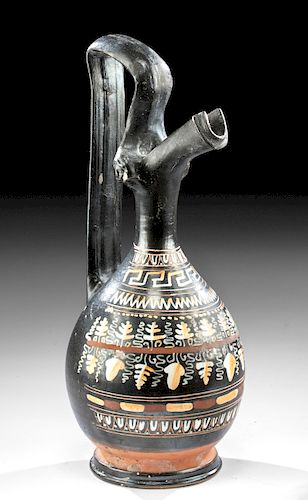Greek Gnathian Pottery Prochous - Finely Decorated
Lot 41
About Seller
Artemis Gallery
686 S Taylor Ave, Ste 106
Louisville, CO 80027
United States
Selling antiquities, ancient and ethnographic art online since 1993, Artemis Gallery specializes in Classical Antiquities (Egyptian, Greek, Roman, Near Eastern), Asian, Pre-Columbian, African / Tribal / Oceanographic art. Our extensive inventory includes pottery, stone, metal, wood, glass and textil...Read more
Estimate:
$1,400 - $2,000
Absentee vs Live bid
Two ways to bid:
- Leave a max absentee bid and the platform will bid on your behalf up to your maximum bid during the live auction.
- Bid live during the auction and your bids will be submitted real-time to the auctioneer.
Bid Increments
| Price | Bid Increment |
|---|---|
| $0 | $25 |
| $300 | $50 |
| $1,000 | $100 |
| $2,000 | $250 |
| $5,000 | $500 |
| $10,000 | $1,000 |
| $20,000 | $2,500 |
| $50,000 | $5,000 |
| $100,000 | $10,000 |
| $200,000 | $20,000 |
About Auction
By Artemis Gallery
Sep 26, 2019
Set Reminder
2019-09-26 10:00:00
2019-09-26 10:00:00
America/New_York
Bidsquare
Bidsquare : Exceptional Day 1: Antiquities & Asian Art
https://www.bidsquare.com/auctions/artemis-gallery/exceptional-day-1-antiquities-asian-art-4437
Day 1 of an important 2-day auction featuring exceptional, museum-worthy examples of Egyptian, Greek, Etruscan, Roman, Viking, Russian, Near Eastern, as well as Asian Art from China, Japan, Thailand, Vietnam, Burma and India. Artemis Gallery info@artemisgallery.com
Day 1 of an important 2-day auction featuring exceptional, museum-worthy examples of Egyptian, Greek, Etruscan, Roman, Viking, Russian, Near Eastern, as well as Asian Art from China, Japan, Thailand, Vietnam, Burma and India. Artemis Gallery info@artemisgallery.com
- Lot Description
Magna Graecia, South Italic Colonies, Apulia, near Ignazia, ca. 340 to 325 BCE. A wonderful pouring vessel known as a prochous, wheel-thrown and decorated with lustrous black glaze. The vessel is defined by its discoid foot, a bulbous piriform body with a tapered neck, a narrow spout flanked by a pair of stylized human-face maskettes, and a tall handle arching between spout and midsection. The body is intricately embellished with red, white, and yellow fugitive pigment that forms rows of ovolo, Greek key, zigzags, grape and olive leaves, thin vines, alternating red-and-yellow bars, and additional ovolo motifs. Silvery iridescence has formed across some glazed areas and imbues the vessel with an attractive presentation. Size: 3.2" W x 7.375" H (8.1 cm x 18.7 cm).
For a stylistically similar example with slightly varied decorative motifs, please see The British Museum, museum number 1814,0704.585.
Provenance: private J.H. collection, Beaverton, Oregon, USA; ex-Chiltern Antiquities, England
All items legal to buy/sell under U.S. Statute covering cultural patrimony Code 2600, CHAPTER 14, and are guaranteed to be as described or your money back.
A Certificate of Authenticity will accompany all winning bids.
We ship worldwide and handle all shipping in-house for your convenience.
#149632Professional repair to areas of handle, spout, and neck, with resurfacing and overpainting along break lines. Minor fading to fugitive pigment, with nicks and abrasions to body and base, and light encrustations. Great traces of original pigment across front of body, and faint silvery iridescence along glazed surfaces.Condition
- Shipping Info
-
All shipping is handled in-house for your convenience. Your invoice from Artemis Gallery will include shipping calculation instructions. If in doubt, please inquire BEFORE bidding for estimated shipping costs for individual items.
-
- Buyer's Premium



 EUR
EUR CAD
CAD AUD
AUD GBP
GBP MXN
MXN HKD
HKD CNY
CNY MYR
MYR SEK
SEK SGD
SGD CHF
CHF THB
THB















